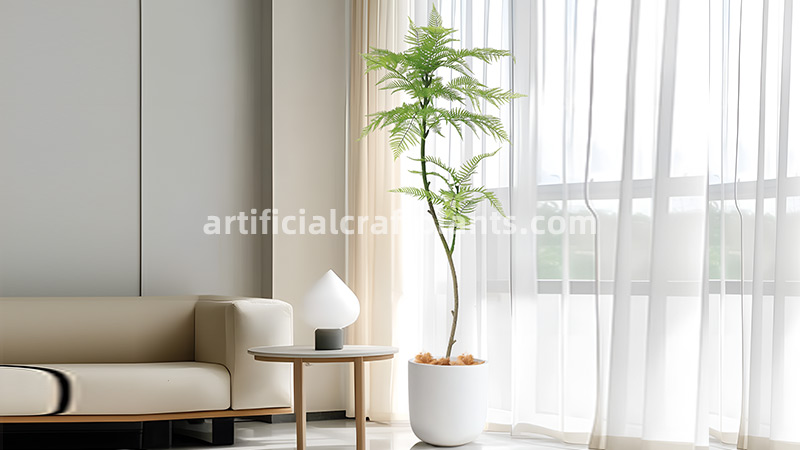Nothing frustrates a buyer more than artificial plants that don’t last. Imagine investing in bulk greenery, only to see leaves fade, stems crack, or materials degrade within months. In the B2B market, durability isn’t just a preference—it’s a necessity.
How can B2B buyers ensure they source artificial plants that stand the test of time?
This guide breaks down the key factors influencing artificial plant longevity, compares materials, and provides actionable tips to help businesses make durable, high-quality purchases.
What Determines the Durability of Artificial Plants?
Artificial plants vary greatly in lifespan depending on several factors:
- Material Quality – Some materials resist fading, moisture, and cracking better than others.
- Manufacturing Techniques – High-end processes ensure stronger construction and longer lifespans.
- Environmental Exposure – UV rays, humidity, and temperature fluctuations impact durability.
- Maintenance & Cleaning – Proper care helps prevent premature wear and tear.
Comparing Materials: Which Last the Longest?
Choosing the right material is the first step toward ensuring durability. Here’s a breakdown of the most common options:
| Material Type | Average Lifespan | Durability Features | Best Used For |
|---|---|---|---|
| PU (Polyurethane) | 5-10 years | Flexible, soft, UV-resistant | High-end artificial trees, luxury décor Artificial Plants Direct: Which Artificial Plant Material is Best for Your Space1 |
| PE (Polyethylene) | 7-10 years | Sturdy, waterproof, outdoor-safe | Outdoor greenery, vertical gardens Artificial Plants Direct: Guide to Outdoor Artificial Plants2 |
| Silk Fabric | 3-5 years (indoors) | Soft, delicate, prone to fading | Indoor flowers, ornamental foliage WikiHow: Care for Silk Flowers3 |
| PVC (Polyvinyl Chloride) | 3-7 years | Fire-resistant, cost-effective | Budget-friendly décor, indoor plants |
| EVA (Ethylene Vinyl Acetate) | 5-8 years | Lightweight, water-resistant | Artificial succulents, tropical leaves |
Pro Tip: PU and PE materials offer the best durability for both indoor and outdoor applications.
What Makes an Artificial Plant Truly Long-Lasting?
1. UV Resistance for Fade Prevention
Sunlight is the biggest enemy of artificial plants, causing discoloration and brittleness. Look for:
- Built-in UV inhibitors in the material blend.
- UV spray coatings for additional protection Artificial Plants Direct: Protecting Your Artificial Plants from the Sun4.
- Lab-tested fade resistance under simulated sun exposure.
Ask your supplier: “Do your plants have UV protection, and are they tested for outdoor use?”
2. Weatherproofing for Outdoor Use
Outdoor artificial plants need extra protection against rain, wind, and humidity. The best options feature:
- Waterproof coatings to prevent moisture absorption.
- Reinforced stems & branches to withstand wind.
- Rust-resistant metal frames in larger artificial trees.
3. Strong, Flexible Construction
Durable artificial plants should be:
- Bendable, not brittle – PU and PE allow shaping without breaking.
- Seamlessly molded – Fewer glued parts mean less risk of detachment.
- Stable in base design – A solid foundation prevents tipping and damage.
4. Fire-Retardant Properties for Safety
For commercial spaces, fire-resistant artificial plants are essential. Look for:
- Flame-retardant certification in compliance with global safety standards Nearly Natural: Safety5.
- Non-toxic, eco-friendly fireproofing without harmful chemicals.
Common Myths About Artificial Plant Durability
"All artificial plants eventually look bad, no matter the quality."True
False! Premium materials with UV and weather resistance can last over a decade [Artificial Plants Direct: The Lifespan of Artificial Plants](https://www.artificialplantsdirect.com/blogs/learning-center/the-lifespan-of-artificial-plants)[^6].
"Indoor and outdoor plants use the same materials."False
False! Outdoor plants require additional UV protection and waterproofing.
Conclusion
For B2B buyers, selecting durable artificial plants means prioritizing PU and PE materials, verifying UV and weather resistance, and ensuring solid construction. Investing in longevity not only reduces replacement costs but also enhances customer satisfaction. Choose wisely, and your artificial plants will stay vibrant for years to come!
-
Explanation: Discusses polyurethane’s durability and flexibility, supporting its 5-10 year lifespan claim. ↩
-
Explanation: Highlights polyethylene’s waterproof and outdoor-safe features, supporting its 7-10 year lifespan. ↩
-
Explanation: Provides care tips for silk flowers, noting their fading tendency and 3-5 year indoor lifespan. ↩
-
Explanation: Offers insights on UV protection importance and selection tips for artificial plants. ↩
-
Explanation: Manufacturer’s safety guide detailing fire-retardant certifications for artificial plants. ↩

Hello everyone, I'm Li!By day, I'm a seasoned expert in the artificial plant industry, starting from the factory floor and working my way up to running my own successful business. In my free time, I’m passionate about running and often join trail runs with friends.Here to share what I've learned—let's grow together!



